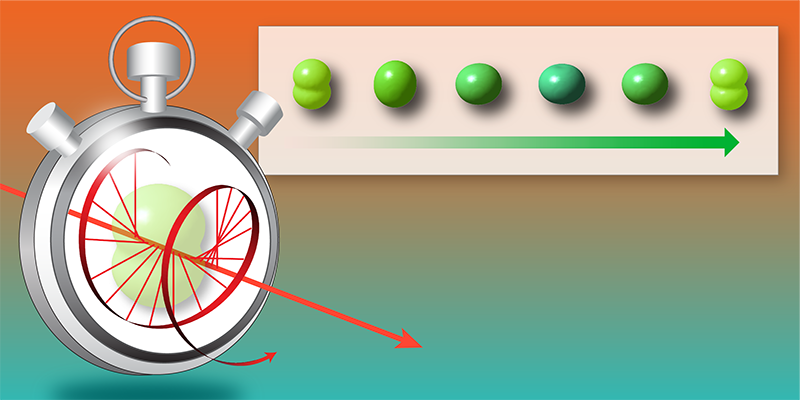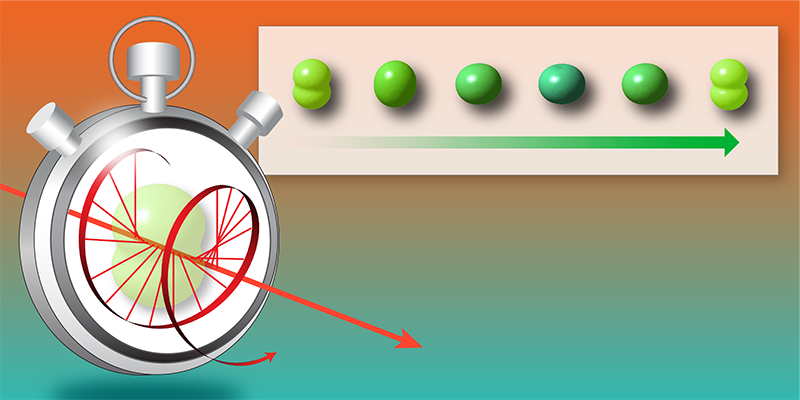Electrons Filming Themselves
Electrons move so quickly inside of atoms and molecules that they are challenging to “capture on film” without blurring the images. One way to take fast snapshots is to ionize an atom or molecule and then use the released electrons as probes of the cloud out of which they originate. Now Gabriel Stewart at Wayne State University in Michigan and colleagues [1] and Antoine Camper at the University of Oslo in Norway and colleagues [2] have improved this “self-probing” technique. The demonstrations could lead to a better understanding of the electron motion that underpins many fundamental processes.
Scientists need to complete three key tasks to measure the evolution of an electron cloud that moves and changes on an ultrafast timescale. The first is to exactly record the beginning of the evolution—analogous to pressing “start” on a mechanical stopwatch. The second is to track how much time has gone by since the starting event—analogous to precisely measuring the ticking of the stopwatch’s second hand. And the third is to take a quick snapshot of the electron cloud so that it looks frozen in time.
In many experiments, these three steps are accomplished by using two ultrashort laser pulses known as the pump and the probe. The pump starts the motion of the electron cloud, and the cloud’s evolution is precisely tracked by finely controlling the delay between the two pulses and using the probe to capture a snapshot of the system at that delay. Progress in ultrafast laser science has allowed attosecond-scale electron dynamics to be studied in this manner [3, 4]. However, it is technologically challenging to control the duration of both pulses and to ensure that they arrive at the same place at the time of the experimenters’ choosing.
The two teams take advantage of schemes in which the pump, delay, and probe steps are all performed within a single laser pulse, thereby eliminating the need to control multiple pulses in space and time. In both experiments, this intrinsic pump-and-probe scheme is driven by an intense, infrared laser pulse that starts the clock ticking by inducing tunnel ionization—an ultrafast process in which an electron escapes from an atom or molecule. This ionization initiates movement of the remaining part of the electron cloud. The teams then record the evolving cloud at different times.
Stewart and colleagues use double ionization of an atom by a circularly polarized infrared laser field to measure the evolution of the electron cloud produced when the first electron is ionized (Fig. 1). The rotating electric field of the laser light acts like a clock’s second hand, counting the time between the first and second ionizations and translating the time at which the second electron is released into the direction in which it travels toward a detector [5]. By recording the relative positions of the two electrons on this detector, the team is able to infer the time-dependent shape of the electron cloud. The time it takes for the electric field to make a full revolution is about 2.4 fs, which represents the duration over which the cloud’s dynamics can be followed. By combining this technique with an accurate determination of the ionization time of the first electron, the researchers are able to observe the cloud oscillations in a krypton ion and in a xenon ion, with the latter dynamics being seen for the first time. They find the oscillation periods to be just a few femtoseconds, in excellent agreement with their theoretical predictions.
Meanwhile, Camper and colleagues use a process called high-harmonic generation for self-probing the electron dynamics initiated in a small molecule by tunnel ionization. The electrons released by the ionization are accelerated by the laser field in a looping trajectory. Upon returning to the molecule, they give rise to the emission of high-frequency light (the high harmonics), whose amplitude and phase are sensitive to the characteristics of the remaining electron cloud. The emitted light’s frequency, which depends on the length of time that has elapsed since the tunnel ionization, acts as the second hand of the self-probing clock. Researchers have extensively used this method to measure both the structure and the dynamics of electron clouds [6, 7]. Camper and colleagues beautifully extend the technique to longer time spans by separating different contributions to the harmonic light in both space (position on the detector) and frequency. Using this approach, they see clear evidence of the attosecond-scale electron dynamics induced by the strong laser field in nitrogen and carbon dioxide molecules.
These two studies provide exciting demonstrations of how to harness the concept of self-probing to measure ultrafast electron dynamics. The teams’ methods retain the advantages of pump-and-probe techniques but avoid the technical difficulties of separately controlling and overlapping two ultrafast pulses in space and time. Both experiments show that the time delay in self-probing can be controlled with attosecond precision and that it can extend to the full optical cycle of the strong laser field. In the two current experiments, that period is a few femtoseconds, but one can easily imagine increasing it to tens of femtoseconds if using longer-wavelength driving lasers [8]. It is intriguing to think about the prospects of recording the first few frames of movies that show electrons dancing inside molecules in response to laser light—for example, in the process known as charge migration [4, 9].
References
- G. A. Stewart et al., “Attosecond imaging of electronic wave packets,” Phys. Rev. Lett. 130, 083202 (2023).
- A. Camper et al., “Quantum-path resolved attosecond high-harmonic spectroscopy,” Phys. Rev. Lett. 130, 083201 (2023).
- M. Schultze et al., “Delay in photoemission,” Science 328, 1658 (2010).
- S. Li et al., “Attosecond coherent electron motion in Auger-Meitner decay,” Science 375, 285 (2022).
- P. Eckle et al., “Attosecond angular streaking,” Nat. Phys. 4, 565 (2008).
- O. Smirnova et al., “High harmonic interferometry of multi-electron dynamics in molecules,” Nature 460, 972 (2009).
- S. Baker et al., “Probing proton dynamics in molecules on an attosecond time scale,” Science 312, 424 (2006).
- P. Colosimo et al., “Scaling strong-field interactions towards the classical limit,” Nat. Phys. 4, 386 (2008).
- L. S. Cederbaum and J. Zobeley, “Ultrafast charge migration by electron correlation,” Chem. Phys. Lett. 307, 205 (1999).





